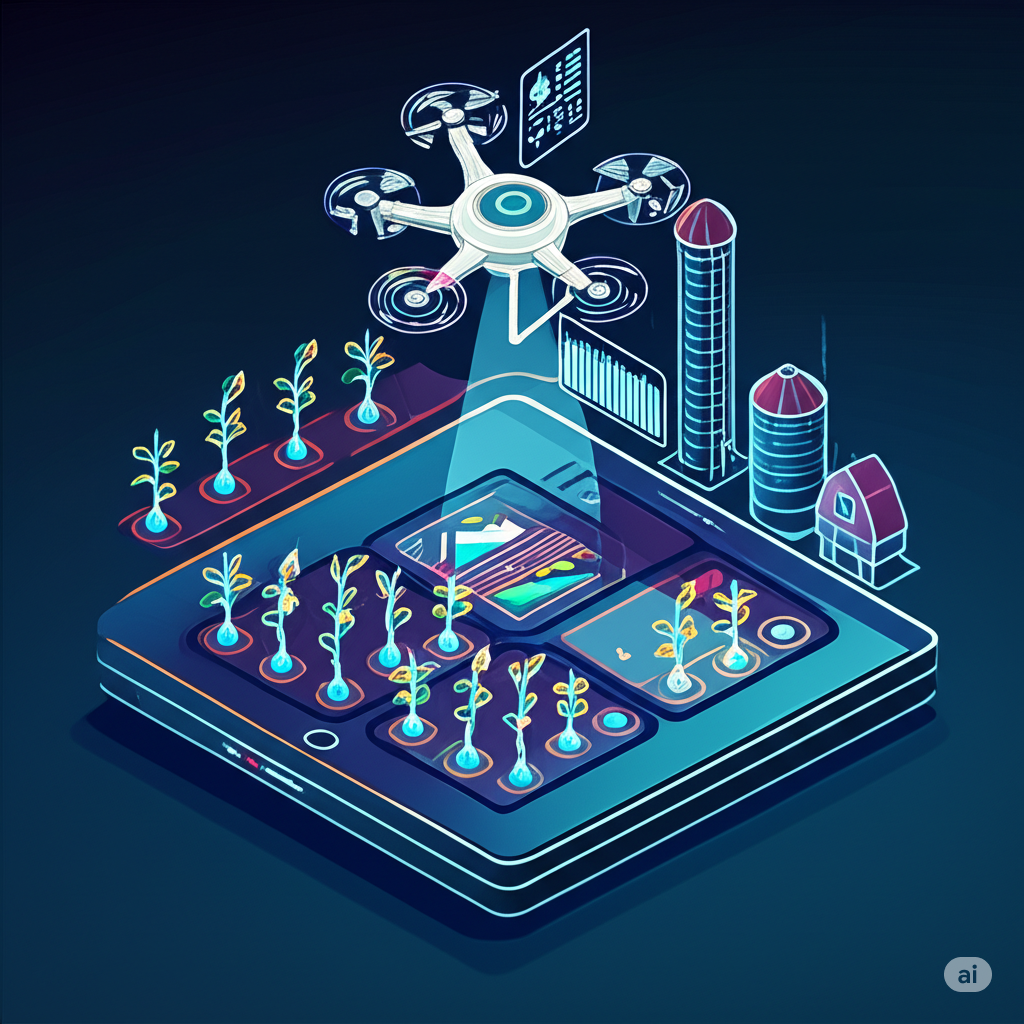Introduction
Agriculture, one of the oldest human activities, is undergoing a profound transformation in the digital age. With the emergence of advanced technologies, especially Big Data Analytics, agriculture is evolving into a more intelligent, data-driven industry. Traditional farming methods are increasingly being supplemented by decisions based on massive amounts of structured and unstructured data. From predicting weather patterns to monitoring soil conditions and forecasting market trends, big data is revolutionizing agricultural decision-making at every level.
This article explores how big data analytics plays a crucial role in enhancing agricultural productivity, sustainability, and resilience. It details the sources of big data in agriculture, the technologies involved, applications in farming decisions, challenges, and the future of data-driven agriculture.
What is Big Data in Agriculture?
Big data refers to vast volumes of information generated at high velocity from various sources and formats. In agriculture, big data includes data from:
- Remote sensing (satellites, drones)
- IoT sensors (soil moisture, weather stations)
- Geographic Information Systems (GIS)
- Farm machinery and equipment
- Social media and news feeds (market demand, commodity prices)
- Government databases (land records, crop insurance)
- Mobile applications used by farmers
Big data analytics involves applying machine learning, AI, and statistical models to this data to generate actionable insights for decision-making.
Sources of Agricultural Big Data
- Remote Sensing Technologies
- Satellites and drones generate images and thermal data to monitor crop health, pest infestations, and water stress.
- Satellites and drones generate images and thermal data to monitor crop health, pest infestations, and water stress.
- IoT Devices and Sensors
- Ground-based sensors track temperature, humidity, soil pH, nutrient levels, and moisture content in real time.
- Ground-based sensors track temperature, humidity, soil pH, nutrient levels, and moisture content in real time.
- Farm Equipment
- Modern tractors and harvesters are equipped with GPS and telemetry systems that track productivity, fuel usage, and planting density.
- Modern tractors and harvesters are equipped with GPS and telemetry systems that track productivity, fuel usage, and planting density.
- Market and Supply Chain Data
- Prices, demand forecasts, logistics, and inventory movement across markets are digitized and available in real time.
- Prices, demand forecasts, logistics, and inventory movement across markets are digitized and available in real time.
- Weather Data
- Hyper-local weather data collected from stations or apps informs irrigation, pesticide spraying, and harvesting decisions.
- Hyper-local weather data collected from stations or apps informs irrigation, pesticide spraying, and harvesting decisions.
- Social and Economic Data
- Farmers’ social media posts, surveys, and digital feedback provide insights into crop preferences, financial constraints, and farming behavior.
Technologies Enabling Big Data in Agriculture
- Cloud Computing: Allows storage and processing of large datasets remotely, accessible from anywhere.
- Artificial Intelligence (AI) & Machine Learning (ML): Algorithms analyze data to predict crop diseases, optimize input usage, and automate decision-making.
- Geospatial Technologies (GIS): Map-based visualization of land use, soil types, and crop distribution for better planning.
- Blockchain: Provides transparent and immutable records of transactions, enhancing traceability in supply chains.
- Mobile Applications: Deliver data insights directly to farmers, even in rural areas with limited infrastructure.
Applications of Big Data in Agricultural Decision-Making
1. Precision Farming
Big data analytics allows farmers to monitor field variability and apply inputs like fertilizers, pesticides, and water precisely where needed. This leads to reduced costs, better resource management, and increased crop yields.
- Example: Using GPS-enabled equipment and soil sensors, a farmer can apply different amounts of fertilizer in different field zones depending on soil nutrient levels.
2. Crop Health Monitoring
Real-time data from drones and sensors helps in early detection of diseases, pest infestations, or nutrient deficiencies. This enables timely intervention to reduce crop loss.
- Example: A farmer receives alerts from an AI system that analyzes drone images to detect early signs of blight in tomato plants.
3. Irrigation Management
By analyzing weather forecasts, evapotranspiration rates, and soil moisture levels, irrigation can be scheduled more efficiently. This conserves water and avoids over-irrigation.
- Example: IoT sensors in a smart irrigation system suggest optimal watering times based on real-time data.
4. Yield Prediction and Forecasting
Big data models help in estimating crop yields based on historical data, weather conditions, and farming practices. Accurate predictions help in planning logistics, storage, and marketing.
- Example: Government agencies use big data to forecast wheat production, allowing better stock and distribution strategies.
5. Risk Management and Insurance
Big data analytics aids in assessing risks related to droughts, floods, and pests. It also enables parametric insurance models where farmers get instant compensation based on predefined weather thresholds.
- Example: A weather-index insurance policy pays automatically if rainfall falls below a certain level during sowing season.
6. Market Intelligence and Supply Chain Optimization
Data from markets, consumer trends, and logistics can guide farmers in choosing what crops to grow and when to sell for maximum profit.
- Example: A farmer in Maharashtra uses an app that predicts onion price trends based on past data and advises on the best time to sell.
7. Policy Formulation and Governance
Governments and institutions can use big data to monitor agricultural patterns, manage subsidies, detect fraud, and target beneficiaries more effectively.
- Example: India’s PM-KISAN scheme can integrate satellite data to verify if registered farmers are actively cultivating their land.
Benefits of Big Data Analytics in Agriculture
| Benefit | Description |
|---|---|
| Resource Optimization | Reduced use of water, fertilizers, and pesticides through data-informed usage. |
| Cost Reduction | Lower input and labor costs due to predictive and automated decision-making. |
| Improved Productivity | Higher yields from precision interventions and timely actions. |
| Environmental Sustainability | Reduced emissions, less chemical runoff, and better soil conservation. |
| Market Efficiency | Better price realization and reduced post-harvest losses. |
| Risk Reduction | Early warnings for adverse weather or disease outbreaks help avoid losses. |
Challenges in Implementing Big Data in Agriculture
Despite its potential, several barriers hinder widespread adoption:
- Lack of Digital Infrastructure:
- Rural areas often face poor internet connectivity and power supply issues.
- Rural areas often face poor internet connectivity and power supply issues.
- Data Ownership and Privacy:
- Unclear policies on who owns agricultural data and how it can be shared raise ethical concerns.
- Unclear policies on who owns agricultural data and how it can be shared raise ethical concerns.
- Low Digital Literacy:
- Many farmers, especially smallholders, are unfamiliar with data tools and apps.
- Many farmers, especially smallholders, are unfamiliar with data tools and apps.
- High Initial Investment:
- Costs of sensors, drones, and software subscriptions can be prohibitive for small farmers.
- Costs of sensors, drones, and software subscriptions can be prohibitive for small farmers.
- Fragmented Data Sources:
- Data often comes from multiple platforms and lacks standardization for integrated analysis.
- Data often comes from multiple platforms and lacks standardization for integrated analysis.
- Language and Accessibility:
- Most digital platforms are in English, limiting access for non-English speaking farmers.
Case Studies: Big Data in Action
1. IBM Watson Decision Platform for Agriculture
IBM’s platform uses AI and big data analytics to provide real-time insights on weather, crop health, and soil conditions. It integrates multiple data sources and delivers customized recommendations to farmers.
2. CropIn Technology (India)
An agri-tech startup using big data, AI, and satellite imagery to help farmers make better decisions. It has digitized over 16 million acres and impacted millions of farmers.
3. Climate Corporation (USA)
Originally a weather insurance company, it now provides big data-driven solutions to monitor climate, manage risk, and optimize inputs in real-time.
The Future of Big Data in Agriculture
The integration of big data with AI, robotics, drones, and blockchain is expected to deepen further in the coming years. Future developments include:
- Hyper-personalized advisory systems for each farmer based on real-time data.
- Predictive modeling of global food supply chains to manage food security.
- Integration of satellite and ground-based data for national-level crop monitoring.
- AI-powered pest and disease detection apps with voice support in regional languages.
To realize this potential, collaboration among governments, private tech firms, NGOs, and farmers is essential. Policies must ensure data sovereignty, access to infrastructure, and inclusion of smallholders.
Conclusion
Big data analytics is no longer a futuristic concept—it is an essential part of modern agriculture. By enabling real-time monitoring, predictive insights, and precision interventions, it empowers farmers to make smarter, faster, and more sustainable decisions. While challenges remain in infrastructure, affordability, and awareness, the trajectory is clear: data is the new fertilizer for the 21st-century farm. Harnessing its power will be critical to feeding a growing population while preserving natural resources and building climate resilience.




